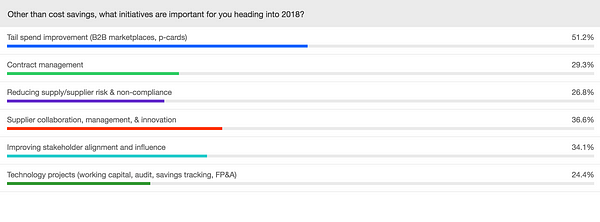Anyone with a little bit of experience in business has heard of the Pareto (or 80/20) “rule.” And this principle drives how organizations are targeting their efforts towards areas that would maximize results. With limited (finite) resources, it is logical to focus them on activities that have the highest impact/value.
- Mass-customization and convenience: customer demands, fueled by “digital trends” and enabled by new manufacturing techniques and tools (e.g., 3D printing), are evolving towards “batch-size zero” and/or niche products. This impacts all sectors and industries, transforming products and services which isn’t without consequences for Procurement that needs to source from a different type of supplier and potentially increasing the number of items sourced.
- The “future of work” and the “gig economy” that also transform the landscape of many industries and that has the consequence to also potentially increase the number of suppliers that an organization works with,
- New technologies like blockchain and Robotic Process Automation (RPA) reduce further process costs eliminating inefficiencies that were one of the reasons why tail spend was left sleeping and unmanaged

Because of all of the above, more and more Procurement teams are (or should be) turning their attention to tail spend management and make it a priority for 2018. The challenge for these organizations is to do it most efficiently and effectively.
Beware of the tail that sleeps…
As already mentioned, the application of the Pareto principle implies that Procurement organizations focus on the 20% of their suppliers and/or materials (or services) that represents 80% of the total spend. It means that the rest of the spend, 20%, is mostly left untouched and unmanaged. For large companies, 20% of the spend can still be an enormous amount. Moreover, and more importantly, it represents a large number of suppliers and materials (or services); 80% of them!
Unmanaged tail spend represents a high risk for organizations because the probability that something wrong happens is high because:
- Occurrence of these purchases is high and is spread across a large number of suppliers and items,
- People “buying” take the easy path to get the product they want with little to no concern about getting the best price or value.
So, companies are exposed to:
- Business continuity and supply risk: even the most insignificant component can bring production lines to a halt if it is not delivered on time or according to specifications. The same applies to the “smallest” suppliers (see the VW story from last year).
- Reputation risk: malpractice and incidents at even the smallest supplier can impact buying organizations. And, the fact that the supplier was not adequately audited/vetted will not make things easier…
Because tail spend is made up of a large number of low-value purchases, some other factors and risk come into play. A typical one is a trade-off between compliance and process costs:
- Compliance (and fraud) risk is high in tail spend. It is because such purchases “fly under the radar” of normal internal controls and checks that apply to higher-value requests and orders and that have been removed (use of P-cards, high approval thresholds,…) to minimize process costs.
- High process costs due to the effort to manage this vast number of transactions (esp. invoices that come mostly out of the standard P2P process and that do not have accompanying purchase orders and/or goods receipts) and the related masterdata.
On top of these potential and real costs, there are also huge savings waiting to be captured in the tail of the spend. And, very often, they are easier to obtain than for the rest of the spend that has been worked on and optimized for years.
“Leading procurement organizations have streamlined their internal processes, capitalized on existing savings opportunities, developed advanced strategic sourcing programs, and consolidated at least 80% of spend down to 20% (or less) of their suppliers. Despite these successes, CPOs remain under pressure to continually unearth new sources of savings. To do so, procurement must expand the scope of its influence and take a hard look at the 20% of spend spread thinly across the remaining 80% of suppliers (called tail spend). Our study data show that 7.1% savings on average can be achieved by better managing tail spend.” — The Hackett Group in “Procurement Key Issues 2016”
Cut the tail and it grows back…

Many organizations realize the potential lying in their tail spend. Therefore they set up a “task force” to get to the bottom of it. Because tail spend comprises purchases done outside of the usual S2P/P2P processes, the task force spends a great deal of time and effort trying to understand it with very insufficient data. Then, they identify potential actions to move some of the tail spend to the “managed spend” area or to reduce the pains and risks it represents:
- Re-sourcing to allocate the spend to suppliers that are part of the 20% the organization manages,
- Tiering and distribution channels to move/transfer the costs and risks to another party and, sometimes, increase volumes and purchasing power. Group Purchasing Organization (GPO) are used for that. Other tactics include the use of distribution channels (traditional distributors or newcomers like Amazon or Alibaba). Sometimes, organizations also ask large tier 1 suppliers to take over the management of their tail spend suppliers. The mark-up applied being still lower than the costs of managing the tail spend directly,
- Technological approach (catalogs, P-cards…) to reduce further process costs and to bring back part of the tail spend into controlled S2P/P2P processes.
However, after a couple of months or years… the tail is back. It is because the organization had a one-time approach to the “problem” and did not put in place a sustainable system to manage its tail spend. And, it is most probably because it understood that tail spend was a problem that needs to be fixed and not something you can take advantage of and that, therefore, requires a specific approach.
Use your tail to your advantage…

In his book, The Long Tail: Why the Future of Business Is Selling Less of More, Chris Anderson explains that the long tail “is a powerful new force in our economy: the rise of the niche. As the cost of reaching consumers drops dramatically, our markets are shifting from a one-size-fits-all model of mass appeal to one of unlimited variety for unique tastes.” And this trend does not only apply to digital offerings but is “an entirely new economic model for business, one that is just beginning to show its power. After a century of obsessing over the few products at the head of the demand curve, the new economics of distribution allow us to turn our focus to the many more products in the tail, which collectively can create a new market as big as the one we already know.”
Since he wrote the book (2006), things have accelerated. The digital revolution changed how commerce is done (online, global, and tailored) and it is now impacting the physical world. As production costs shrink, as capabilities allow for more flexibility, it is now possible to mass-customize products and/or to address niches that were economically not viable, until now. It obviously impacts Procurement as “convenience,” and “customization” creates new needs and participate in maintaining tail spend alive. So, to make tail spend a competitive advantage, organizations must actively manage it instead of ignoring it.
To do so, organizations have to have a specific approach.
“Just as e-sourcing and e-procurement solutions rose up to address strategic sourcing and lower-value catalog spend, tail spend-specific solutions from purchasing automation to prescriptive analytics and consumerized shopping approaches are emerging to help procurement capture the opportunities of effective tail spend management once and for all.” — Spend Matters, Why Procurement’s Persistent Tail Spend Problem is Now Finally Solvable
Digitalization…
So, any technological solution to digitalize processes will reduce process costs and make tail spend more affordable to manage. As a consequence, it removes one of the primary reasons to not take care of it.
The video below from FairMarkIT, a solution provider specialized in tail spend management, illustrates the pain of managing tail spend (in the public sector the problem is sometimes acuter as there are stricter rules and thresholds regarding spend management) and the potential benefits to digitalize processes with solutions specific to tail spend management:
In addition to sourcing activities and spend management activities, new technologies like blockchain can be helpful in tail spend management as it opens the door to new efficiencies.
Furthermore, a by-product of digitalizing tail spend management processes is the increase of data and information on that spend. This data advantage will help Procurement organizations in defining proper strategies (negotiate, aggregate,…) to actively manage some of the spend.
However, and as already mentioned, the technological approach must go beyond the sole automation and process efficiency aspects. There is more value than just that in tail spend and, to capture it, organizations need to manage it in new ways.
Digital transformation
One central aspect to improving the value captured from the tail of the spend has to do with what the digital transformation of Procurement really means.
“The most progressive organizations, however, are converging the individual strategies into an integrated, consumerized strategy that takes the best of B2C process design and applies that to the business’ B2B buying requirements.” — Spend Matters, Why Procurement’s Persistent Tail Spend Problem is Now Finally Solvable
So, Procurement has to also move to an experience-based approach to designing its processes. Like it is the standard practice on the sales/marketing side of the business. To do so, it should not only aim at automating current processes but at obliterating them. Striving to remove frictions changes the perspective. Instead of continuing to do the same as before (and doing most probably like all others — the so-called best practices), it encourages to look at doing things that were previously impossible.
For more on the digital transformation of Procurement: https://medium.com/procurement-tidbits/digital-transformation/home
Cognitive Procurement
The digital transformation described above relies on the use of the latest breakthrough in smart technologies and a new type of collaboration between machines and humans. Beyond the purpose of automating further processes (e.g., decisions and analysis) and of enabling new experiences (e.g., chatbots and conversation-based user-experience), it participates to increasing the overall agility of the Procurement organization. It can respond, among other things, to new/spot demands in a better way. It also transforms the role of the “Procurement system” (people, process, and technology) to a function of a guide.
Guided buying makes perfect sense for tail spend management. End-users are often the “buyers” of what makes the tail because Procurement is focused on the rest of the spend. So, the challenge is to channel these “rogue” activities via a controlled process that is not cumbersome (otherwise users will not follow it), and that does not imply the use of an excessive amount of resources. Guidance would be provided based on:
- the analysis of the considerable mass of data that is contained in tail spend (semantics, classification, pattern recognition,…),
- learnings from each interaction and transaction (personal preferences, item/service characteristics, and attributes, supplier capabilities,…),
- interoperability between systems (internal, suppliers, marketplaces, data providers,…)
- smart workflows (to trigger the right process steps based on the purchase, context, and to, when needed, integrate the right people into it).
For more on Cognitive Procurement: https://medium.com/procurement-tidbits/cognitive-procurement/home

Tail spend: I do not want to see it, nor hear about it, nor talk about it…
So, to conclude, Procurement organizations must change the way they look at tail spend. It is because the primary reason they give to not manage it (too costly from a process point of view) is actually the reason why they should not ignore it (too costly from a business point of view).
Article by channel:
Everything you need to know about Digital Transformation
The best articles, news and events direct to your inbox
Read more articles tagged: Featured







